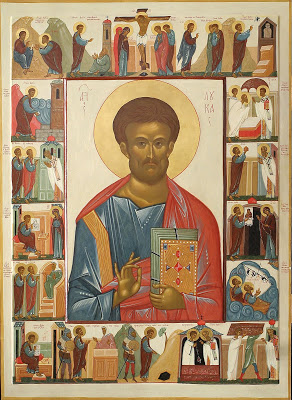St Luke the Evangelist
Today is the Feast of St Luke the Evangelist.

Who was Luke and what do we know about him?
St Luke wrote the third and fifth books of the New Testament-the eponymous Gospel according to St Luke, and The Acts of the Apostles. Evidence that the Church has held to this view reaches as far back as the middle of the second century-to put it another way, we know that with a hundred years or so the Church recognised Luke as the author of these books and there is no evidence which postulates an alternative author.
Luke was a Gentile: St Paul says this in Colossians 4 vv 10-11, 14
My fellow prisoner Aristarchus sends you his greetings, as does Mark, the cousin of Barnabas. Jesus, who is called Justus, also sends greetings. These are the only Jews among my co-workers for the kingdom of God, and they have proved a comfort to me. … Our dear friend Luke, the doctor, and Demas send greetings.
This comment has traditionally caused commentators to conclude that Luke was a Gentile. If this were true, it would make Luke the only writer of the New Testament who can clearly be identified as not being Jewish. Luke is also identified as a doctor.
Noticeable in his writings is the “I and we” passages in the Acts of the Apostles. These are understood to indicate that Luke was an eye witness to what was happening in St Paul’s life at the time. Due to the fact that these sections begin when St Paul arrives at Troas, it has been suggested that Luke was a resident of that town. According to the Anti-Marcionite Prologue to the Gospel According to St Luke (the edition we have dates from the 4th century but probably contains material from the Second Century):
Luke, was born in Antioch, by profession, was a physician.[9] He had become a disciple of the apostle Paul and later followed Paul until his [Paul’s] martyrdom. Having served the Lord continuously, unmarried and without children, filled with the Holy Spirit he died at the age of 84 years.
It is likely that the Birth Narrative in St Luke’s Gospel came from direct contact with Mary, the Mother of God. We might glean this not only from the tenderness of the way Luke reports the Birth of Christ, but also because there is a persistent Church Tradition of close contact between Mary and Luke. Luke is by tradition, the very first writer of icons-the very first one was of Mary holding the Baby Jesus.
![]()
Luke is also the writer of the icons known as the Black Madonna of Czestochowa and Our Lady of Vladirmir. He was also said to have painted Saints Peter and Paul, and to have illustrated a gospel book with a full cycle of miniatures.


Tradition is a concept which some people, even Christians are wary of. During the Medieval Period, the relics of St Luke were taken to Venice. In 1992, Metropolitan Ieronymous of Thebes and Lavathia-the area where St Luke was originally buried, asked the Archbishop of Padua (whose diocese covered the Church where the relics lay, if he would return some, at least, of the relics so that St Luke could be laid to rest where he was originally buried. (Just out of interest, Metropolitan Ieronymous is now the Archbishop of Athens and all Greece-the chief hierarch of the Church of Greece)
One of the results of this request was that scientists did a survey of the relics and confirmed that they were those of an individual of Syrian descent who died between 416 BC and AD 72
Once again Science confirms the Truth of Christian Tradition, the question then remains, why do people continue to question Church Tradition?
